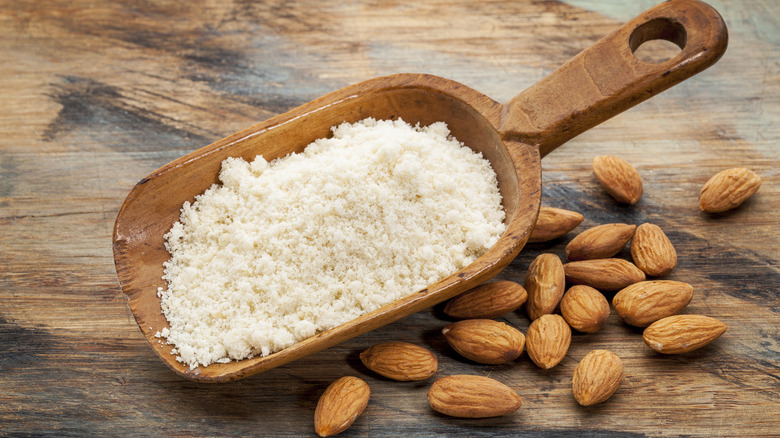What's The Difference Between Almond Flour And Wheat Flour?
For years, you may have considered baking flour your most reached-for and most trusted baking ingredient. But after many easygoing weekends spent preparing batches of cookies and raising loaves of homemade bread, you may have discovered that refined white flour is nutritionally barren (per WebMD). And now, after looking at flour alternatives that can give your pancakes some health benefits, you also may have run into a bit of a baking problem — you just can't seem to decide between switching out this traditional ingredient for wheat or almond flour.
By their nature, ingredients made with wheat, a nutrient with a high vitamin and fiber count per Healthline, and almonds, which contain a lot of protein and healthy fats according to the same website, are considered good for you. However, while both flours will help you make much more nutritionally balanced baked goods than your usual cooking must-have, there is one big difference between the two you need to know that will affect the way you bake and, in certain cases, your health.
Only one of these flours is gluten-free
The process of making wheat flour and almond flour may have nothing in common (after all, almond flour is made from nuts), but white and wheat flour are produced in a similar way. While making white flour involves grinding a wheat kernel stripped of its bran (which actually houses most of the kernel's nutritional benefits), wheat flour is made by pulverizing a kernel that's completely intact (per Healthline). However, although wheat flour has a lot more benefits than the white variety, because they are both made from wheat, it still has one thing in common with traditional flour — both ingredients have gluten.
Some people can't eat gluten, but it's been long considered an essential ingredient in baking. A type of protein found in all wheat products, per The Celiac Disease Foundation, gluten is a leavening agent that ensures dough-based treats like cinnamon rolls don't end up flat. That being said, generally, wheat flour is recommended for your homemade sandwich bread. Meanwhile, almond flour can be used to make crumbly sweets like lemon cake.
Bake reports that you can still use eggs as a make-shift binding agent if you're set on using almond flour to bake gluten-free bread. However, if gluten isn't a problem and you find yourself making more brownies than sourdough bread, there are a few other differences between almond and wheat flour you need to know.
Almond and wheat flour differ in nutritional value
While almond and wheat flour may both be good for you, their benefits are more different than similar. According to Healthline, if you break down the two white flour alternatives by serving size, you'll find that ½ cup of wheat flour will give your bread potassium and iron. However, if you used the same amount of almond flour in your cookies, you'd enjoy a treat that not only has potassium but calcium, magnesium, and vitamin E.
Of course, although both flours also provide protein and fiber, almond flour trumps wheat flour's protein content. And so by using it, Women's Health Magazine reports you can keep your hunger levels low. However, if you're trying to get more fiber into your diet (after all, is there any better way to meet your daily fiber requirement than with pancakes?) wheat flour is the way to go.
In the end, which flour you choose depends on your baking and health goals. But just remember, that if you're not on a strictly gluten-free diet, you don't have to settle for one or the other. For a full-time baker, the pantry can never be stocked with too many ingredients.


